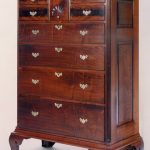We may receive a commission when you use our affiliate links. However, this does not impact our recommendations.
There are almost as many workbench types in existence as there are woodworkers. Many of the examples on our website, like the one Roy Underhill displays in the above video excerpt, are variations on the Roubo workbench. I’ve seen some pretty awesome portable bench varieties, such as the Paulk bench, elsewhere on the web. And then, of course, there is the combination Workmate-plus-laundry-machine (and whatever other horizontal surface you have). That’s the type I’m still using.
Like purchasing a solid home – another thing I’m working on – developing the right workbench may be a matter of shopping around until you feel comfortable with the plan.
But what I always love about Roy and “The Woodwright’s Shop” is that he throws that type of slow, long-range planning out the window. “Life’s too short” would seem to be one of Roy’s mottos (although that’s not a direct quote).
In addition to 2 full episodes on this Roubo-style bench, season 27 of “The Woodwright’s Shop” includes 2 box-making shows, 4 shop tours and much more. The full season is now available in our store, so buy your copy today and get started on some of the projects.
We are on pace to have almost the entire Roy Underhill collection available in our store by the end of this year. That will be a pretty astounding body of video content. Since I’m not quite as fast as Roy, I’m hoping to have just one proper workbench ready to use by about the same time.
What style of bench do you use?
–Dan Farnbach
Here are some supplies and tools we find essential in our everyday work around the shop. We may receive a commission from sales referred by our links; however, we have carefully selected these products for their usefulness and quality.











I never had a “real” bench until I built one last winter. I was always moving and never set up anything resembling a planned, organized workshop. The top is a 30″ X 68” X 3” composite. The bottom layer is 3/4 baltic birch plywood to hold fasteners well, the center is 2 layers of MDF for weight and stability and the top is a skin of 4/4 hard maple. The front edge is a 3″ X 4” solid maple beam with dog holes and a wagon vise on the right front and a vintage Record (read flea market) face vice on the left. The front of the bench is one of the face vice jaws and the other is a 1 1/2” X 4” X 12” thick maple plate. There are two sliding tray under the bench for hand tools and a bottom shelf for miscellaneous stuff. The legs are 5 layers of baltic birch laminated and the aprons and stretchers are three layers of laminated Baltic birch plywood. The base is held together with mortise and tenon joins and 3/4” Baltic birch plywood panels. The base design is from a FWW design (more or less). The top is finished with Watco. Having never had a proper bench this has been a real treat. One of it’s best attributes is, with the tool trays, it weighs in at over 300 pounds. I am looking to put some retractable casters on it so I can move it around as my shop is a bit tight.
In all the years that I have been woodworking, I have made 8 or more different styles of benches, from portable to “not likely to move much.” I love them all and all have had different things that I liked less. Four of the benches were made from the same wood.
The way I see it, as the work changes, the requirements change – and the tools to do the work evolve as well. The bench is one of the tools. Just because you bought this or that, made this or that, doesn’t make it the only option. You really can have more that one plane, saw, and bench (if you have space). The two main things are that you love what you are doing and do it safely!
I have two that I use. One is 40″ tall, mounted to the back wall. and 8′ long by 30″ deep. That has the halogen light, the magnifier/light, and the machinist’s vise. Thereupon do I my close-up work, electric fixin’, and plan reading. My sharpening station occupies one end, but can be moved when needed.
The other is more centrally located, 33 1/2″ tall, by 5′ long and 28″ wide. That’s where the woodworking tends to happen.
It was only a few weeks ago that I built something resembling a work bench, and that breaks most of Chris’s Rules. Prior to that it was any flat(ish) surface, often the floor.